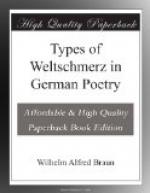Der Mond zieht traurig durch
die Sphaeren,
Denn all die Seinen ruhn im
Grab;
Drum wischt er sich die hellen
Zaehren
Bei Nacht an unsern Blumen
ab.[175]
The forceful directness of Lenau’s metaphors from nature is aptly shown in the following comparison of two passages, one from Hoelderlin’s “An die Natur,” the other from Lenau’s “Herbstklage,” in which both poets employ the same poetic fancy to express the same idea.
Tot ist nun, die mich erzog
und stillte,
Tot ist nun die jugendliche
Welt,
Diese Brust, die einst ein
Himmel fuellte,
Tot und duerftig wie ein Stoppelfeld.[176]
If we compare the simile in the last line with the corresponding metaphor used by Lenau in the following stanza,—
Wie der Wind zu Herbsteszeit
Mordend hinsaust in den Waeldern,
Weht mir die Vergangenheit
Von des Glueckes Stoppelfeldern,[177]
the greater artistic effectiveness of the latter figure will be at once apparent.
The idea that nature is cruel, even murderous, as suggested in the opening lines of the stanza just quoted, seems in the course of time to have become firmly fixed in the poet’s mind, for he not only uses it for poetic purposes, but expresses his conviction of the fact on several occasions in his conversations and letters. Tossing some dead leaves with his stick while out walking, he is said to have exclaimed: “Da seht, und dann heisst es, die Natur sei liebevoll und schonend! Nein, sie ist grausam, sie hat kein Mitleid. Die Natur ist erbarmungslos!"[178] It goes without saying that in such a conception of nature the poet could find no amelioration of his Weltschmerz.[179]
In summing up the results of our discussion of Lenau’s Weltschmerz, it would involve too much repetition to mention all the points in which it stands, as we have seen, in striking contrast to that of Hoelderlin. Suffice it to recall only the most essential features of the comparison: the predominance of hereditary and pathological traits as causative influences in the case of Lenau; the fact that whereas Hoelderlin’s quarrel was largely with the world, Lenau’s was chiefly within himself; the passive and ascetic nature of Lenau’s attitude, as compared with the often hopeful striving of Hoelderlin; the patriotism of the latter, and the relative indifference of the former; Lenau’s strongly developed erotic instinct, which gave to his relations with Sophie such a vastly different influence upon his Weltschmerz from that exerted upon Hoelderlin by his relations with Diotima; and finally the marked difference in the attitude of these two poets toward nature.




